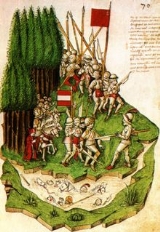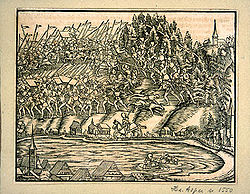
Battle of Morgarten
Encyclopedia
The Battle of Morgarten occurred on November 15, 1315, when a Swiss Confederation force of 1,500 infantry archers ambushed a group of Austrian
soldiers of the Holy Roman Empire
near the Morgarten Pass. The Swiss, led by Werner Stauffacher
, thoroughly defeated the Austrians, who were under the command of Duke Leopold I of Austria.
. But the Confederates of Uri
, Schwyz
and Unterwalden
, who had formalized the Swiss Confederation in 1291, held imperial freedom letters from former emperors granting them local autonomy within the empire.
In 1314, Duke Louis IV of Bavaria (who would become Louis IV, Holy Roman Emperor
) and Frederick the Handsome
, a Habsburg
prince, each claimed the crown of the Holy Roman Emperor
. The Confederates supported Louis IV because they feared the Habsburgs would annex their countries as Habsburg property — as they already had tried to do in the late 13th century.
War broke out over a dispute between the Confederates of Schwyz and the Habsburg-protected monastery of Einsiedeln
regarding some pastures, and eventually the Confederates of Schwyz conducted a raid on the monastery.
s on horseback — to crush the rebellious confederates, planning a surprise attack from south via Lake Aegeri and the Morgarten pass and counting on a complete victory over the rebellious peasants.
The Confederates of Schwyz — supported by the Confederates of Uri, who feared for their autonomy, but not supported by the Confederates of Unterwalden — expected the army in the west near the village of Arth
, where they had erected fortifications. A historically plausible legend tells of the Knight of Huenenberg who shot an arrow into the camp of the Confederates with the attached message "watch out on St. Otmar's day at the Morgarten".
The Confederates prepared a road-block and an ambush at a point between Lake Aegeri and Morgarten pass where the small path led between the steep slope and a swamp. When about 1500 men attacked from above with rocks, logs and halberds, the knights had no room to defend themselves and suffered a crushing defeat, while the foot soldiers in the rear fled back to the city of Zug
. A chronicler described the Confederates, unfamiliar with the customs of battles between knights, as brutally butchering everything that moved and everyone unable to flee. This founded the reputation of the Confederates as barbaric, yet fierce and respectable fighters.

Within a month of the battle, in December 1315, the Confederates renewed the oath of alliance made in 1291, initiating the phase of growth of the Old Swiss Confederacy
.
Within forty years, cities including Lucerne
, Zug
, Zürich
and Bern had joined the confederation.
The victory of the Confederates left them in their virtual autonomy and gave them a breathing-space of some sixty years before the next Habsburg attack resulted in the Battle of Sempach
(1386).
Austrian
Austrian can refer to:* Someone from Austria or of Austrian descent. See Austrians.* Someone who is considered an Austrian citizen. See Austrian nationality law.* Something associated with the country Austria...
soldiers of the Holy Roman Empire
Holy Roman Empire
The Holy Roman Empire was a realm that existed from 962 to 1806 in Central Europe.It was ruled by the Holy Roman Emperor. Its character changed during the Middle Ages and the Early Modern period, when the power of the emperor gradually weakened in favour of the princes...
near the Morgarten Pass. The Swiss, led by Werner Stauffacher
Werner Stauffacher
Werner Stauffacher was supposedly the name of the representative of the canton of Schwyz, one of the three founding cantons at the legendary Rütlischwur of 1291, as told by Aegidius Tschudi....
, thoroughly defeated the Austrians, who were under the command of Duke Leopold I of Austria.
Background
Toward the end of the thirteenth century, the House of Habsburg coveted the area around the Gotthard Pass in order to secure this shortest passage to ItalyItaly
Italy , officially the Italian Republic languages]] under the European Charter for Regional or Minority Languages. In each of these, Italy's official name is as follows:;;;;;;;;), is a unitary parliamentary republic in South-Central Europe. To the north it borders France, Switzerland, Austria and...
. But the Confederates of Uri
Canton of Uri
Uri is one of the 26 cantons of Switzerland and a founding member of the Swiss Confederation. It is located in Central Switzerland. The canton's territory covers the valley of the Reuss River between Lake Lucerne and the St. Gotthard Pass. German is the primary language spoken in Uri...
, Schwyz
Schwyz
The town of is the capital of the canton of Schwyz in Switzerland.The Federal Charter of 1291 or Bundesbrief, the charter that eventually led to the foundation of Switzerland, can be seen at the Bundesbriefmuseum.-History of the toponym:...
and Unterwalden
Unterwalden
Unterwalden is the old name of a forest-canton of the Old Swiss Confederacy in central Switzerland, south of Lake Lucerne, consisting of two valleys or Talschaften, now organized as two half-cantons, an upper part, Obwalden, and a lower part, Nidwalden.Unterwalden was one of the three participants...
, who had formalized the Swiss Confederation in 1291, held imperial freedom letters from former emperors granting them local autonomy within the empire.
In 1314, Duke Louis IV of Bavaria (who would become Louis IV, Holy Roman Emperor
Louis IV, Holy Roman Emperor
Louis IV , called the Bavarian, of the house of Wittelsbach, was the King of Germany from 1314, the King of Italy from 1327 and the Holy Roman Emperor from 1328....
) and Frederick the Handsome
Frederick I of Austria (Habsburg)
Frederick the Handsome or the Fair , from the House of Habsburg, was Duke of Austria and Styria from 1308 as Frederick I as well as King of Germany from 1314 as Frederick III until his death.-Biography:He was the second son of King Albert I of Germany with his wife Elisabeth of...
, a Habsburg
Habsburg
The House of Habsburg , also found as Hapsburg, and also known as House of Austria is one of the most important royal houses of Europe and is best known for being an origin of all of the formally elected Holy Roman Emperors between 1438 and 1740, as well as rulers of the Austrian Empire and...
prince, each claimed the crown of the Holy Roman Emperor
Holy Roman Emperor
The Holy Roman Emperor is a term used by historians to denote a medieval ruler who, as German King, had also received the title of "Emperor of the Romans" from the Pope...
. The Confederates supported Louis IV because they feared the Habsburgs would annex their countries as Habsburg property — as they already had tried to do in the late 13th century.
War broke out over a dispute between the Confederates of Schwyz and the Habsburg-protected monastery of Einsiedeln
Einsiedeln Abbey
Einsiedeln Abbey is a Benedictine monastery in the town of Einsiedeln in the Canton of Schwyz, Switzerland. The abbey is dedicated to Our Lady of the Hermits, the title being derived from the circumstances of its foundation, from which the name Einsiedeln is also said to have originated...
regarding some pastures, and eventually the Confederates of Schwyz conducted a raid on the monastery.
The battle
Frederick's brother, Leopold of Austria, led an army of 3000 to 5000 men — about one third of them knightKnight
A knight was a member of a class of lower nobility in the High Middle Ages.By the Late Middle Ages, the rank had become associated with the ideals of chivalry, a code of conduct for the perfect courtly Christian warrior....
s on horseback — to crush the rebellious confederates, planning a surprise attack from south via Lake Aegeri and the Morgarten pass and counting on a complete victory over the rebellious peasants.
The Confederates of Schwyz — supported by the Confederates of Uri, who feared for their autonomy, but not supported by the Confederates of Unterwalden — expected the army in the west near the village of Arth
Arth
Arth is a municipality in Schwyz District in the canton of Schwyz in Switzerland.-Geography:Arth has an area, , of . Of this area, 40.8% is used for agricultural purposes, while 46.3% is forested...
, where they had erected fortifications. A historically plausible legend tells of the Knight of Huenenberg who shot an arrow into the camp of the Confederates with the attached message "watch out on St. Otmar's day at the Morgarten".
The Confederates prepared a road-block and an ambush at a point between Lake Aegeri and Morgarten pass where the small path led between the steep slope and a swamp. When about 1500 men attacked from above with rocks, logs and halberds, the knights had no room to defend themselves and suffered a crushing defeat, while the foot soldiers in the rear fled back to the city of Zug
Zug
Zug , is a German-speaking city in Switzerland. The name ‘Zug’ originates from fishing vocabulary; in the Middle Ages it referred to the right to ‘pull up’ fishing nets and hence to the right to fish.The city of Zug is located in the Canton of Zug and is its capital...
. A chronicler described the Confederates, unfamiliar with the customs of battles between knights, as brutally butchering everything that moved and everyone unable to flee. This founded the reputation of the Confederates as barbaric, yet fierce and respectable fighters.
Aftermath

Within a month of the battle, in December 1315, the Confederates renewed the oath of alliance made in 1291, initiating the phase of growth of the Old Swiss Confederacy
Growth of the Old Swiss Confederacy
The growth of the Old Swiss Confederacy began as an alliance between the communities of the valleys in the Central Alps to facilitate the management of common interests such as free trade and to ensure the peace along the important trade routes through the mountains...
.
Within forty years, cities including Lucerne
Lucerne
Lucerne is a city in north-central Switzerland, in the German-speaking portion of that country. Lucerne is the capital of the Canton of Lucerne and the capital of the district of the same name. With a population of about 76,200 people, Lucerne is the most populous city in Central Switzerland, and...
, Zug
Zug
Zug , is a German-speaking city in Switzerland. The name ‘Zug’ originates from fishing vocabulary; in the Middle Ages it referred to the right to ‘pull up’ fishing nets and hence to the right to fish.The city of Zug is located in the Canton of Zug and is its capital...
, Zürich
Zürich
Zurich is the largest city in Switzerland and the capital of the canton of Zurich. It is located in central Switzerland at the northwestern tip of Lake Zurich...
and Bern had joined the confederation.
The victory of the Confederates left them in their virtual autonomy and gave them a breathing-space of some sixty years before the next Habsburg attack resulted in the Battle of Sempach
Battle of Sempach
An armistice was agreed upon on 12 October, followed by a peace agreement valid for one year, beginning on 14 January 1387.The battle was a severe blow to Austrian interests in the region, and allowed for the further growth of the Old Swiss Confederacy....
(1386).

